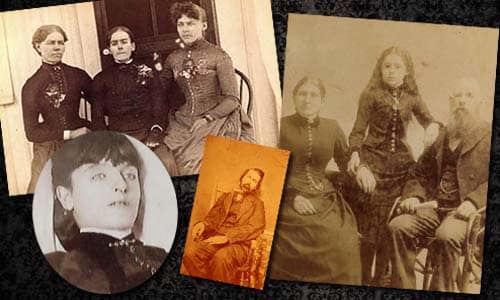Guest writer VIOLET FENN explains why she is fascinated by the Victorian practice of post mortem photography
The most common question I’m asked when people find out what it is that I do is simple: “Why?”
Collecting post mortem photography isn’t top of the hobby list for most people. But I’ve been fascinated by the subject for years and have been writing The Skull Illusion since December 2010. The site has attracted a loyal following since the very beginning, which makes me think that I’m not the only odd one out there.
Post mortem photography
In our modern age we are conditioned to avoid (and in consequence, fear) death. Most of us have very little contact with the dying – at the time of writing I am 42 years old and have yet to see a dead body “in the flesh”.
My only direct brush with death was my maternal grandfather, who died in a nursing home when I was in my 20s. I took care of the arrangements and was genuinely surprised at just how sanitized the entire procedure was.
I was arranging the disposal of a dead human being, yet not once did I have to deal with anything even faintly icky. It involved paperwork, lots of paperwork, and deciding on buffet options for the wake.
The funeral director did offer the option of viewing “the body” but Gran didn’t want to. That was another thing that bemused me – the minute my Granddad had passed away he was demoted from being “Albert, husband of Emily” to merely “the body”.
I envy the Victorians their pragmatic approach to death, along with their automatic assumption that the deceased would be kept at home and cared for lovingly by their family until the funeral service took place. An interesting aside is that our modern “living rooms” are so named because in time gone by they were literally the room in which the living sat, as opposed to the parlour – aka the “death room” – in which your late Uncle Charlie might be laid out.
Another factor in the development of my morbid curiosity was having kids.
As soon as you are a parent, the worst thing in the world that could happen to you is the death of your child.
There is no fear quite like that associated with realising that you are entirely responsible for the safety of this little person – the world is filled with previously unnoticed deathtraps.
I confront what scares me
Knowledge is power, and my automatic reaction to anything that scares me has always been to find out as much about it as possible. Understanding that death is the fate that none of us can avoid goes a long way towards assuaging pointless fear.
However, this psychological approach is only part of the reason I curate The Skull. Many of these photographs are simply and undeniably beautiful, their eerie serenity at odds with the fact that we are looking at a dead person.
Tellingly, if people ask what I do for a living I tend to reply that I am a jewellery designer. As much as I’d love to be open about my work I have had too many unpleasant reactions to telling people that I (in their interpretation) “collect photos of dead people”. There is often an assumption that I get some sort of sick pleasure from looking at the images, which misses the point entirely.
But this is the year the Skull gets out of the mourning closet. I will be appearing at Cybher (a conference for female bloggers of all persuasions) as part of a talk given by Cressida Downing, aka The Book Analyst, about turning blogs into books. The vast majority of women bloggers are still geared towards the fashion or parenting industries, so this ‘coming out’ both excites and terrifies me.
There is always going to be a certain level of voyeurism involved in my work. Looking at a person that we know is dead but who is laid as to appear to be sleeping, there is always the thrill of fear which comes with wondering whether their eyes might suddenly blink open and focus on us, the viewer.
In the meantime, does the act of looking keep the person somehow present – or at least remembered? Or are they now purely art?
You can see more post mortem photography Violet Fenn’s website The Skull Illusion.


